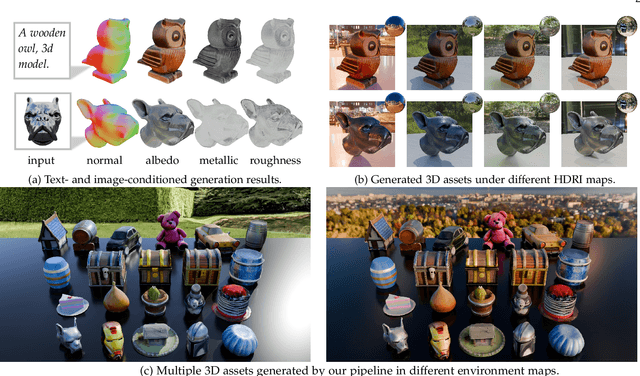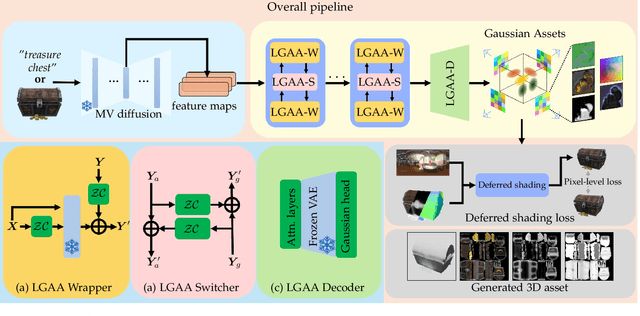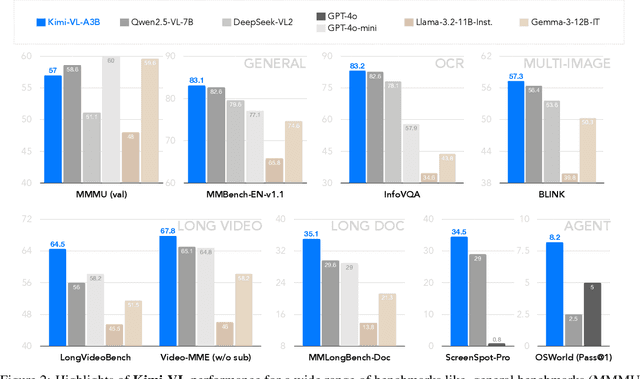Jin Xie
DreamLifting: A Plug-in Module Lifting MV Diffusion Models for 3D Asset Generation
Sep 09, 2025



Abstract:The labor- and experience-intensive creation of 3D assets with physically based rendering (PBR) materials demands an autonomous 3D asset creation pipeline. However, most existing 3D generation methods focus on geometry modeling, either baking textures into simple vertex colors or leaving texture synthesis to post-processing with image diffusion models. To achieve end-to-end PBR-ready 3D asset generation, we present Lightweight Gaussian Asset Adapter (LGAA), a novel framework that unifies the modeling of geometry and PBR materials by exploiting multi-view (MV) diffusion priors from a novel perspective. The LGAA features a modular design with three components. Specifically, the LGAA Wrapper reuses and adapts network layers from MV diffusion models, which encapsulate knowledge acquired from billions of images, enabling better convergence in a data-efficient manner. To incorporate multiple diffusion priors for geometry and PBR synthesis, the LGAA Switcher aligns multiple LGAA Wrapper layers encapsulating different knowledge. Then, a tamed variational autoencoder (VAE), termed LGAA Decoder, is designed to predict 2D Gaussian Splatting (2DGS) with PBR channels. Finally, we introduce a dedicated post-processing procedure to effectively extract high-quality, relightable mesh assets from the resulting 2DGS. Extensive quantitative and qualitative experiments demonstrate the superior performance of LGAA with both text-and image-conditioned MV diffusion models. Additionally, the modular design enables flexible incorporation of multiple diffusion priors, and the knowledge-preserving scheme leads to efficient convergence trained on merely 69k multi-view instances. Our code, pre-trained weights, and the dataset used will be publicly available via our project page: https://zx-yin.github.io/dreamlifting/.
SNNSIR: A Simple Spiking Neural Network for Stereo Image Restoration
Aug 17, 2025Abstract:Spiking Neural Networks (SNNs), characterized by discrete binary activations, offer high computational efficiency and low energy consumption, making them well-suited for computation-intensive tasks such as stereo image restoration. In this work, we propose SNNSIR, a simple yet effective Spiking Neural Network for Stereo Image Restoration, specifically designed under the spike-driven paradigm where neurons transmit information through sparse, event-based binary spikes. In contrast to existing hybrid SNN-ANN models that still rely on operations such as floating-point matrix division or exponentiation, which are incompatible with the binary and event-driven nature of SNNs, our proposed SNNSIR adopts a fully spike-driven architecture to achieve low-power and hardware-friendly computation. To address the expressiveness limitations of binary spiking neurons, we first introduce a lightweight Spike Residual Basic Block (SRBB) to enhance information flow via spike-compatible residual learning. Building on this, the Spike Stereo Convolutional Modulation (SSCM) module introduces simplified nonlinearity through element-wise multiplication and highlights noise-sensitive regions via cross-view-aware modulation. Complementing this, the Spike Stereo Cross-Attention (SSCA) module further improves stereo correspondence by enabling efficient bidirectional feature interaction across views within a spike-compatible framework. Extensive experiments on diverse stereo image restoration tasks, including rain streak removal, raindrop removal, low-light enhancement, and super-resolution demonstrate that our model achieves competitive restoration performance while significantly reducing computational overhead. These results highlight the potential for real-time, low-power stereo vision applications. The code will be available after the article is accepted.
WeatherDiffusion: Weather-Guided Diffusion Model for Forward and Inverse Rendering
Aug 09, 2025Abstract:Forward and inverse rendering have emerged as key techniques for enabling understanding and reconstruction in the context of autonomous driving (AD). However, complex weather and illumination pose great challenges to this task. The emergence of large diffusion models has shown promise in achieving reasonable results through learning from 2D priors, but these models are difficult to control and lack robustness. In this paper, we introduce WeatherDiffusion, a diffusion-based framework for forward and inverse rendering on AD scenes with various weather and lighting conditions. Our method enables authentic estimation of material properties, scene geometry, and lighting, and further supports controllable weather and illumination editing through the use of predicted intrinsic maps guided by text descriptions. We observe that different intrinsic maps should correspond to different regions of the original image. Based on this observation, we propose Intrinsic map-aware attention (MAA) to enable high-quality inverse rendering. Additionally, we introduce a synthetic dataset (\ie WeatherSynthetic) and a real-world dataset (\ie WeatherReal) for forward and inverse rendering on AD scenes with diverse weather and lighting. Extensive experiments show that our WeatherDiffusion outperforms state-of-the-art methods on several benchmarks. Moreover, our method demonstrates significant value in downstream tasks for AD, enhancing the robustness of object detection and image segmentation in challenging weather scenarios.
VGGT-Long: Chunk it, Loop it, Align it -- Pushing VGGT's Limits on Kilometer-scale Long RGB Sequences
Jul 22, 2025Abstract:Foundation models for 3D vision have recently demonstrated remarkable capabilities in 3D perception. However, extending these models to large-scale RGB stream 3D reconstruction remains challenging due to memory limitations. In this work, we propose VGGT-Long, a simple yet effective system that pushes the limits of monocular 3D reconstruction to kilometer-scale, unbounded outdoor environments. Our approach addresses the scalability bottlenecks of existing models through a chunk-based processing strategy combined with overlapping alignment and lightweight loop closure optimization. Without requiring camera calibration, depth supervision or model retraining, VGGT-Long achieves trajectory and reconstruction performance comparable to traditional methods. We evaluate our method on KITTI, Waymo, and Virtual KITTI datasets. VGGT-Long not only runs successfully on long RGB sequences where foundation models typically fail, but also produces accurate and consistent geometry across various conditions. Our results highlight the potential of leveraging foundation models for scalable monocular 3D scene in real-world settings, especially for autonomous driving scenarios. Code is available at https://github.com/DengKaiCQ/VGGT-Long.
AD-GS: Object-Aware B-Spline Gaussian Splatting for Self-Supervised Autonomous Driving
Jul 16, 2025Abstract:Modeling and rendering dynamic urban driving scenes is crucial for self-driving simulation. Current high-quality methods typically rely on costly manual object tracklet annotations, while self-supervised approaches fail to capture dynamic object motions accurately and decompose scenes properly, resulting in rendering artifacts. We introduce AD-GS, a novel self-supervised framework for high-quality free-viewpoint rendering of driving scenes from a single log. At its core is a novel learnable motion model that integrates locality-aware B-spline curves with global-aware trigonometric functions, enabling flexible yet precise dynamic object modeling. Rather than requiring comprehensive semantic labeling, AD-GS automatically segments scenes into objects and background with the simplified pseudo 2D segmentation, representing objects using dynamic Gaussians and bidirectional temporal visibility masks. Further, our model incorporates visibility reasoning and physically rigid regularization to enhance robustness. Extensive evaluations demonstrate that our annotation-free model significantly outperforms current state-of-the-art annotation-free methods and is competitive with annotation-dependent approaches.
Mask6D: Masked Pose Priors For 6D Object Pose Estimation
Jul 09, 2025Abstract:Robust 6D object pose estimation in cluttered or occluded conditions using monocular RGB images remains a challenging task. One reason is that current pose estimation networks struggle to extract discriminative, pose-aware features using 2D feature backbones, especially when the available RGB information is limited due to target occlusion in cluttered scenes. To mitigate this, we propose a novel pose estimation-specific pre-training strategy named Mask6D. Our approach incorporates pose-aware 2D-3D correspondence maps and visible mask maps as additional modal information, which is combined with RGB images for the reconstruction-based model pre-training. Essentially, this 2D-3D correspondence maps a transformed 3D object model to 2D pixels, reflecting the pose information of the target in camera coordinate system. Meanwhile, the integrated visible mask map can effectively guide our model to disregard cluttered background information. In addition, an object-focused pre-training loss function is designed to further facilitate our network to remove the background interference. Finally, we fine-tune our pre-trained pose prior-aware network via conventional pose training strategy to realize the reliable pose prediction. Extensive experiments verify that our method outperforms previous end-to-end pose estimation methods.
VoxelSplat: Dynamic Gaussian Splatting as an Effective Loss for Occupancy and Flow Prediction
Jun 05, 2025Abstract:Recent advancements in camera-based occupancy prediction have focused on the simultaneous prediction of 3D semantics and scene flow, a task that presents significant challenges due to specific difficulties, e.g., occlusions and unbalanced dynamic environments. In this paper, we analyze these challenges and their underlying causes. To address them, we propose a novel regularization framework called VoxelSplat. This framework leverages recent developments in 3D Gaussian Splatting to enhance model performance in two key ways: (i) Enhanced Semantics Supervision through 2D Projection: During training, our method decodes sparse semantic 3D Gaussians from 3D representations and projects them onto the 2D camera view. This provides additional supervision signals in the camera-visible space, allowing 2D labels to improve the learning of 3D semantics. (ii) Scene Flow Learning: Our framework uses the predicted scene flow to model the motion of Gaussians, and is thus able to learn the scene flow of moving objects in a self-supervised manner using the labels of adjacent frames. Our method can be seamlessly integrated into various existing occupancy models, enhancing performance without increasing inference time. Extensive experiments on benchmark datasets demonstrate the effectiveness of VoxelSplat in improving the accuracy of both semantic occupancy and scene flow estimation. The project page and codes are available at https://zzy816.github.io/VoxelSplat-Demo/.
Sketchy Bounding-box Supervision for 3D Instance Segmentation
May 22, 2025Abstract:Bounding box supervision has gained considerable attention in weakly supervised 3D instance segmentation. While this approach alleviates the need for extensive point-level annotations, obtaining accurate bounding boxes in practical applications remains challenging. To this end, we explore the inaccurate bounding box, named sketchy bounding box, which is imitated through perturbing ground truth bounding box by adding scaling, translation, and rotation. In this paper, we propose Sketchy-3DIS, a novel weakly 3D instance segmentation framework, which jointly learns pseudo labeler and segmentator to improve the performance under the sketchy bounding-box supervisions. Specifically, we first propose an adaptive box-to-point pseudo labeler that adaptively learns to assign points located in the overlapped parts between two sketchy bounding boxes to the correct instance, resulting in compact and pure pseudo instance labels. Then, we present a coarse-to-fine instance segmentator that first predicts coarse instances from the entire point cloud and then learns fine instances based on the region of coarse instances. Finally, by using the pseudo instance labels to supervise the instance segmentator, we can gradually generate high-quality instances through joint training. Extensive experiments show that our method achieves state-of-the-art performance on both the ScanNetV2 and S3DIS benchmarks, and even outperforms several fully supervised methods using sketchy bounding boxes. Code is available at https://github.com/dengq7/Sketchy-3DIS.
WeatherGen: A Unified Diverse Weather Generator for LiDAR Point Clouds via Spider Mamba Diffusion
Apr 18, 2025Abstract:3D scene perception demands a large amount of adverse-weather LiDAR data, yet the cost of LiDAR data collection presents a significant scaling-up challenge. To this end, a series of LiDAR simulators have been proposed. Yet, they can only simulate a single adverse weather with a single physical model, and the fidelity of the generated data is quite limited. This paper presents WeatherGen, the first unified diverse-weather LiDAR data diffusion generation framework, significantly improving fidelity. Specifically, we first design a map-based data producer, which can provide a vast amount of high-quality diverse-weather data for training purposes. Then, we utilize the diffusion-denoising paradigm to construct a diffusion model. Among them, we propose a spider mamba generator to restore the disturbed diverse weather data gradually. The spider mamba models the feature interactions by scanning the LiDAR beam circle or central ray, excellently maintaining the physical structure of the LiDAR data. Subsequently, following the generator to transfer real-world knowledge, we design a latent feature aligner. Afterward, we devise a contrastive learning-based controller, which equips weather control signals with compact semantic knowledge through language supervision, guiding the diffusion model to generate more discriminative data. Extensive evaluations demonstrate the high generation quality of WeatherGen. Through WeatherGen, we construct the mini-weather dataset, promoting the performance of the downstream task under adverse weather conditions. Code is available: https://github.com/wuyang98/weathergen
Kimi-VL Technical Report
Apr 10, 2025



Abstract:We present Kimi-VL, an efficient open-source Mixture-of-Experts (MoE) vision-language model (VLM) that offers advanced multimodal reasoning, long-context understanding, and strong agent capabilities - all while activating only 2.8B parameters in its language decoder (Kimi-VL-A3B). Kimi-VL demonstrates strong performance across challenging domains: as a general-purpose VLM, Kimi-VL excels in multi-turn agent tasks (e.g., OSWorld), matching flagship models. Furthermore, it exhibits remarkable capabilities across diverse challenging vision language tasks, including college-level image and video comprehension, OCR, mathematical reasoning, and multi-image understanding. In comparative evaluations, it effectively competes with cutting-edge efficient VLMs such as GPT-4o-mini, Qwen2.5-VL-7B, and Gemma-3-12B-IT, while surpassing GPT-4o in several key domains. Kimi-VL also advances in processing long contexts and perceiving clearly. With a 128K extended context window, Kimi-VL can process diverse long inputs, achieving impressive scores of 64.5 on LongVideoBench and 35.1 on MMLongBench-Doc. Its native-resolution vision encoder, MoonViT, further allows it to see and understand ultra-high-resolution visual inputs, achieving 83.2 on InfoVQA and 34.5 on ScreenSpot-Pro, while maintaining lower computational cost for common tasks. Building upon Kimi-VL, we introduce an advanced long-thinking variant: Kimi-VL-Thinking. Developed through long chain-of-thought (CoT) supervised fine-tuning (SFT) and reinforcement learning (RL), this model exhibits strong long-horizon reasoning capabilities. It achieves scores of 61.7 on MMMU, 36.8 on MathVision, and 71.3 on MathVista while maintaining the compact 2.8B activated LLM parameters, setting a new standard for efficient multimodal thinking models. Code and models are publicly accessible at https://github.com/MoonshotAI/Kimi-VL.
 Add to Chrome
Add to Chrome Add to Firefox
Add to Firefox Add to Edge
Add to Edge